This Sourdough Sweet Potato Bread is a unique mashup of sweet potato, red lentil flour, bread flour and a hint of cinnamon. The ingredients blend well to create a slightly sweet and moist loaf with good keeping quality due to the potatoes and sourdough.
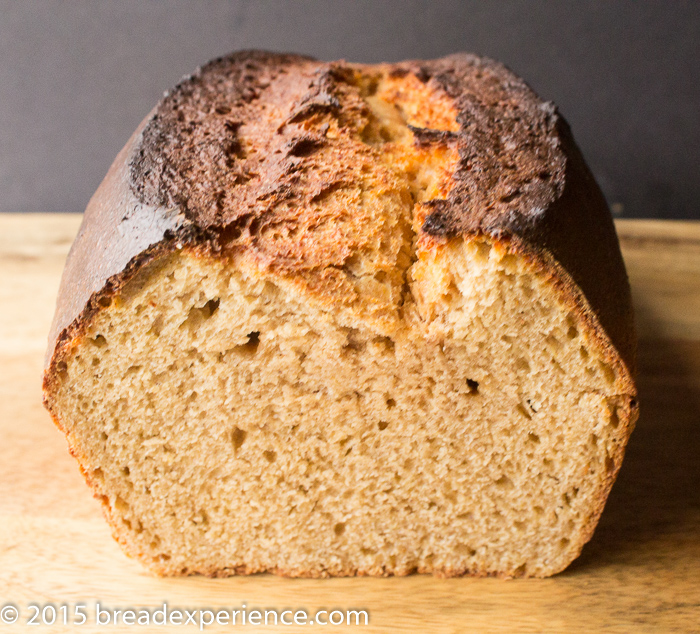
The concept for this bread has been floating around in my head for over a year. It began when I made Potato Bread for toast and butter last year and shared a photo of it with a friend.
This friend is a “think-outside-the-box” kinda guy and his first response was “I wonder if you could make this with sweet potatoes since they are better for you than white potatoes.”
I thought it was a fabulous idea and filed it away for future reference. Every now and then the idea would resurface, but I wasn’t sure what other ingredients I wanted to use to complete it so I would file it away again.
Then, I made Sourdough Green Pea and Matcha Bread.
My creative juices were flowing, and I started brainstorming other ways to incorporate dried peas or lentils in bread. It just so happened that I had some red lentils in the cupboard and a couple of sweet potatoes on the counter just waiting their turn to be used for dinner. This combination really appealed to me, but there was still something missing.
To determine the final ingredient, I asked myself, “what spice goes well with sweet potatoes?”
I’ve always enjoyed sweet potato crunch so with that dish in mind, I realized the missing ingredient was cinnamon. I suppose you could also add nuts to the mix, but that wasn’t the texture I was looking for in a sandwich-type loaf so I didn’t incorporate nuts in this creation.
I am very pleased with the results of this experiment.
May I introduce to you the new potato bread on the block: Sourdough Sweet Potato Bread, circa 2016.
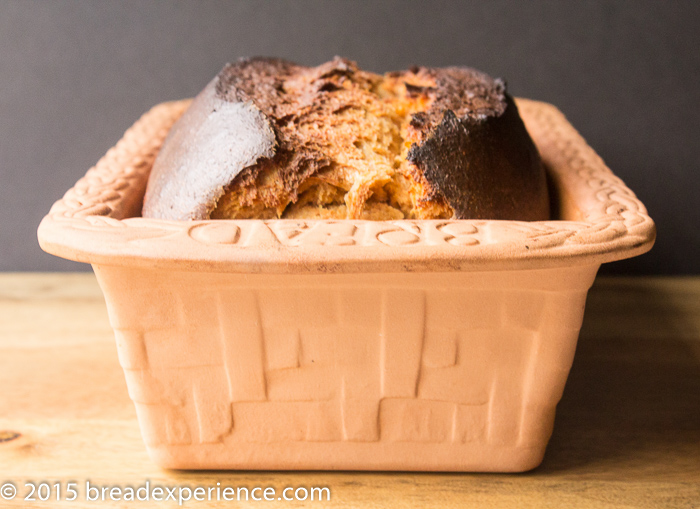
If you don’t have a sourdough starter already, you might enjoy making one from scratch. My favorite is this apple starter.
Print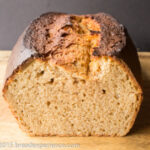
Sourdough Sweet Potato Bread with Red Lentil Flour
- Yield: 1 Loaf 1x
Description
This Sourdough Sweet Potato Bread is a unique mashup of sweet potato, red lentil flour, bread flour and a hint of cinnamon.
Ingredients
- 65 grams active sourdough starter (100% hydration) **See Notes**
- 130 grams cooked sweet potatoes, mashed
- 250 grams milk, scalded, then cooled
- 40 grams honey
- 50 grams butter, softened
- 65 grams red lentil flour (grind red lentils in a grain mill, coffee grinder, or high-powered blender)
- 465 grams bread flour
- 2 tsp. cinnamon
- 65 grams water, if needed – I used potato water
- 10 grams sea salt
- 25 grams water, if needed to dissolve salt
- Milk or egg for wash
Instructions
Day 1: Prepare the Dough
- Cook the sweet potatoes, let cool. Reserve the potato water in case extra hydration is needed. (I ended up with 65 grams of potato water. You may have more or less.)
- Scald the milk, then let it cool to room temperature.
- Add the sourdough to a large mixing bowl and add in the rest of the wet ingredients except the potato water. Stir well.
- Whisk together all of the dry ingredients except the salt.
- Add the dry ingredients to the wet ingredients and mix using a wooden spoon or Danish dough whisk.
- Add the reserved potato water, a little at a time, if the dough is too dry.
- Mix thoroughly until a sticky mass forms
- Cover and allow the dough to autolyse for 20 – 30 minutes until the flour is fully hydrated.
- Sprinkle the salt over the dough and add the additional 25 grams of water, if needed to fully dissolve the salt and work it into the dough.
- Remove the dough to a counter and knead until it is soft and pliable – about 5 to 7 minutes.
- Place the dough in a clean, lighted oiled bowl, and cover with plastic wrap, or bees wrap.
- Let it bulk ferment for 5 hours at room temperature or until almost doubled in size and continue with the shaping and final proof.
- Alternately, let the dough bulk ferment for 2 – 3 hours, then place in the refrigerator overnight. (This is the method I used.)
Day 2: Shape, Final Proof and Bake the Loaf
- The next day, remove the dough from the refrigerator and allow it to warm up to room temperature, about 2 -3 hours, depending on the temperature in your kitchen.
- Place the dough on a lightly-floured counter and press into a (6 x 8 inch) rectangle.
- Fold the top down to the center and press tightly to form surface tension.
- Fold the bottom up to the center and press tightly to form surface tension.
- Lightly tuck the ends of the loaf under and place the loaf seam-side down in a greased loaf pan. (I used a stoneware 9 x 5-inch loaf pan. A 9 – 10-inch non stick or ceramic loaf pan would work as well.)
- Allow the loaf to proof for 2 -3 hours until it reaches the top of the pan.
- Preheat the oven to 400 degrees F. (See notes)
- Brush the top of the loaf with an egg or milk wash using a pastry brush.
- Score the loaf straight down the middle about 1/4 to 1/2-inch deep using a lame or sharp knife.
- Place the loaf in the preheated oven and let it bake for about 35 to 40 minutes, or until the top is a deep brown color. Tent the top with foil if the top starts to brown too quickly.
- Cool completely before slicing. Waiting 24 hours is even better to allow the flavor to develop and the crumb to set.
Notes
I preheated the oven to 425 degrees F. and after placing the loaf in the oven, reduced the temperature to 400 degrees F. As a result, the top of the loaf got a bit too dark. This didn’t affect the flavor of the loaf, but if you prefer a deep brown and not a dark brown, I recommend either tenting the loaf partway through the bake cycle or bake at a lower temperature.
If you don’t have a sourdough starter:
1) You can create one from scratch. It will take several days before you can use it in this recipe. My favorite is this one https://www.breadexperience.com/you-are-apple-of-my-starter/
Or
2) Use dried yeast instead. Add 1/2 teaspoon of instant dried yeast to the dry ingredients. Allow the dough to bulk ferment overnight (8-12 hours) in the refrigerator. If you want to ferment the dough longer, use less yeast – about 1/4 tsp.
- Category: Sweet Potato Bread
- Cuisine: Naturally Leavened Bread
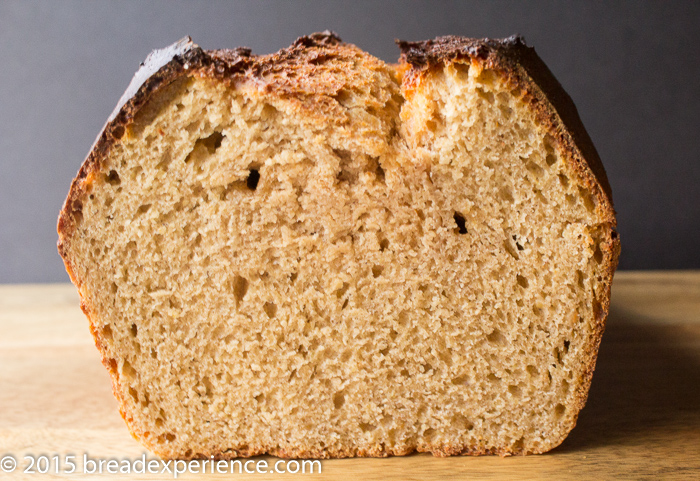
Happy Baking!
Cathy
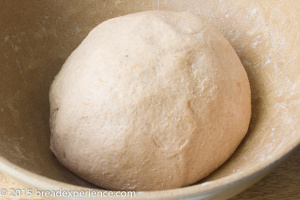
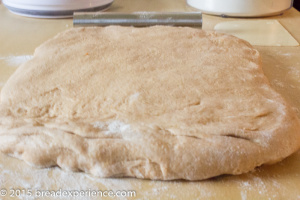
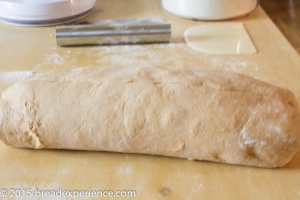


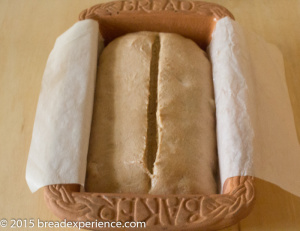
Laura says
Hello,
The hydration of the starter is 100 % ?
Thanks
Cathy says
Hi Laura,
Yes, the hydration of the starter should be 100%. I’ll add that to the post. Thanks!
Shoko says
This bread sounds gorgeous and I am looking so forward to trying it out. I don’t have any experience with sourdough starters and am not really sure where I could get such a thing in Germany. Can I make the bread with the sour dough starter maybe by letting it ferment in the fridge a bit longer? Thanks!
Cathy says
Hi Shoko,
Thank you for your inquiry. I updated the notes on the recipe to include the instructions below.
You can create a sourdough starter from scratch. Here is my favorite method https://www.breadexperience.com/you-are-apple-of-my-starter/. It takes several days to get it going.
Or, instead of using the starter, add some dried yeast to the dry ingredients and yes, you can let it ferment longer in the fridge. If you give it a long ferment – 12-18 or 24 hours, you may only need about 1/4 tsp of instant dried yeast.
If you try it, let me know how it goes.
Happy Baking!
Cathy
Shoko says
Hi Cathy,
Thank you do much for giving me alternatives to using a sourdough starter. I used dried yeast and let the dough rise for 3 days in the fridge. My dough didn’t rise much, so I think I will use fresh yeast next time.
I really liked the bread, it was soft, fluffy and full of flavour. It is more of a sweet than savoury bread, so I wouldn’t personally use it as a sandwich bread. This recipe is definitely a keeper. I will try it next time either with no honey at all or half the amount. Not sure how that would affect the bread though.
My kids loved it and it is an excellent idea of adding healthy ingredients to bread. Thank you so much!
Cathy says
Hi Shoko,
Thank you for sharing your experience using dried yeast in this bread instead of a sourdough starter. I’m so glad your kids liked it.
There are a lot of variables to consider. From your note, it looks like you’re saying the dough didn’t rise. If that is the case, it could be that you need to increase the amount of dried yeast. I haven’t tried fresh yeast in this bread, but that’s certainly an option.
If the bread didn’t rise in the oven, it could be because the dough fermented too long in the refrigerator.
If it was too sweet for your liking, decreasing the amount of honey is also an option. Just keep in mind the yeast needs something to feed on. And, the honey, along with the butter, provides enrichment to get that soft and fluffy bread.
Happy Baking!
Cathy